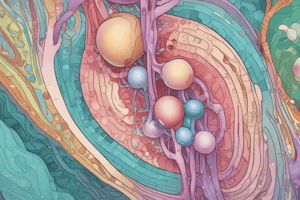Podcast
Questions and Answers
What is identified as a significant waste product generated by muscles?
What is identified as a significant waste product generated by muscles?
- Ammonia
- Creatinine (correct)
- Urea
- Lactate
Which statement best reflects the focus of the content regarding health?
Which statement best reflects the focus of the content regarding health?
- Avoiding shiny objects.
- The importance of reducing creatinine levels. (correct)
- Maintaining a diet high in fats.
- Emphasizing fat detection in chemical tests.
What aspect of health is indirectly addressed in the content?
What aspect of health is indirectly addressed in the content?
- Muscle function and its effects on performance. (correct)
- The impact of diet on cholesterol levels.
- Skin care practices.
- Emotional well-being.
Which of the following can often be misinterpreted from the content?
Which of the following can often be misinterpreted from the content?
What might the mention of 'no fat detected in chem test' suggest about dietary habits?
What might the mention of 'no fat detected in chem test' suggest about dietary habits?
Flashcards
Creatinine
Creatinine
A substance produced by muscle breakdown and excreted in urine. It can be tested for in a blood test or urine test.
Semi-Automatic Weapon
Semi-Automatic Weapon
A type of firearm that uses a mechanism to automatically reload after each shot.
Fully Automatic Weapon
Fully Automatic Weapon
A type of firearm that fires multiple rounds with single trigger pull. Considered a fast, high-power weapon with a high rate of fire.
Automatic Weapon
Automatic Weapon
Signup and view all the flashcards
Manual Weapon
Manual Weapon
Signup and view all the flashcards
Study Notes
Urinalysis, Renal Function Tests, and Renal Disorders and Calculi
-
Urinalysis testing involves examining urine samples for microscopic structures to identify and quantify various substances, including abnormalities, cellular components, and infectious agents.
-
Structures like hemosiderin, mucous threads, cylindroids, oval fat bodies, free fat, bacteria, yeast, parasites, spermatozoa, and confusing artifacts may be found in urine samples.
-
Hemosiderin is a free granule found in casts, and it's linked to hemolytic events, such as incompatible transfusions and sickle-cell anemia.
-
In urinalysis, mucous threads have a low refractive index and are located using microscopic techniques similar to those used for casts. Small amounts are typically normal.
-
Cylindroids are similar to casts.
-
Oval fat bodies result from fatty degeneration or lipid absorption in the kidneys.
Lipiduria
- Lipiduria, or fat in the urine, isn't always detected through chemical tests because lipids accumulate in kidney tubules.
- Conditions causing lipiduria include chronic glomerulo nephritis, diabetes, eclampsia, lipid nephrosis, nephrotic syndrome, toxic renal poisoning, extensive injuries, and fractures of long bones.
Bacteria in Urine
- Bacteria are usually absent in urine samples but could be present due to contamination from urethra, vagina, or external sources.
- A fresh, properly collected specimen containing bacteria suggests a urinary tract infection (UTI), especially if combined with high white blood cell (WBC) counts.
- Bacteria presence is often reported using semi-quantitative terms like trace, 1+, 2+, etc.
- White blood cell counts are more accurate indicators of an infection than nitrite levels.
Yeast in Urine
- Yeast in urine samples is frequently colorless and smooth and can sometimes appear as budding structures.
- Yeast, particularly Candida albicans, can be mistaken for red blood cells (RBCs) in microscopic analysis.
- Yeast, like bacteria, can be reported in semi-quantitative terms. Presence is often correlated with conditions like diabetes, or diminished immune function.
Parasites in Urine
- Some parasites are indigenous to the urinary tract, arising naturally.
- Contamination from vaginal or fecal matter also leads to parasite presence in urine.
- No reliable chemical test is available to definitively diagnose parasites in urine.
- WBCs may be present in urine samples with parasites.
Spermatozoa in Urine
- Oval-shaped sperm heads with long tails are sometimes seen normally in urine specimens.
Confusing Artifacts-Fibers and Hair
- Fiber and hair-like structures may sometimes be present in urine samples but are not meaningful findings on their own.
Urine Automation:
- Automated urinalysis systems can save time, and standardize urinalysis procedures.
- There are semi-automated instruments and fully automated instruments.
- However, some important microscopic findings, such as Trichomonas, may be missed by automated analysis.
Kidney (Renal) Function Tests
- A crucial test for determining and monitoring nephron damage is the glomerular filtration rate (GFR) test or Clearance test.
- Creatinine, a byproduct of muscle metabolism, is widely used in measuring GFR. A standard value, based on body size, is used as a reference to evaluate GFR.
- The calculation for creatinine clearance involves specific factors to calculate adjusted creatinine clearance.
Urinary Calculi (Renal Lithiasis)
- Urinary calculi or kidney stones are made up of crystallates that form around proteins and mucus.
- The most frequent crystalline component of kidney stones is calcium oxalate (making up 75% of kidney stones).
- Other components of kidney stones can include phosphate, magnesium, ammonium, apatite (calcium phosphate and carbonate), uric acid, and cystine.
Pyelonephritis:
- Acute and chronic pyelonephritis can cause serious and permanent damage to kidneys.
- The cause of pyelonephritis is an upper urinary tract infection (UTI).
- Dipstick analysis might show protein, WBCs, esterase, and nitrites (depending on the bacteria involved).
- Microscopically, WBCs, WBC casts, bacteria, and bacteria casts may also be observed.
Nephrotic Syndrome:
- Nephrotic syndrome results from damage that increases glomerulus permeability.
- An abnormal amount of protein is present in urine.
- The microscopy findings frequently include numerous casts of various types, as well as oval fat bodies and free fat, often combined with diminished plasma proteins and elevated plasma lipids.
Studying That Suits You
Use AI to generate personalized quizzes and flashcards to suit your learning preferences.



